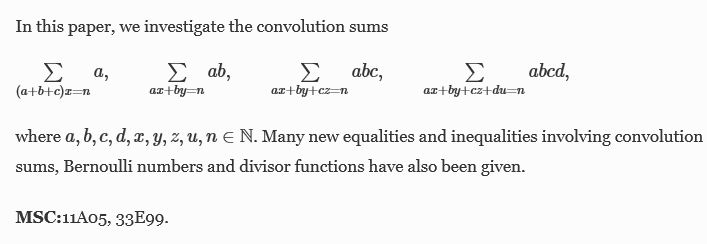논문
Wonju Jeon (Seung-Ho Kang, Joo-Baek Leem, Sang-Hee Lee) | PHYSICA A 392 (2013)
Some Identities on the Generalized q-Bernoulli, q-Euler and q-Genocchi Polynomials
Daeyeoul Kim (Burak Kurt, Veli Kurt) | Abstract and Applied Analysis 2013 (2013)
A Diophantine problem concerning polygonal numbers
Daeyeoul Kim (Akos Pinter,Yoon Kyung Park) | Bulletin of the Australian Mathematical Society 88 (2013)
Suh-Ryung Kim (Yoshio Sano, Boram Park, Jung Yeun Lee) | Annals of Combinatorics 17 (2013)
New approach to twisted q-Bernoulli polynomials
Daeyeoul Kim (Yoon Kyung Park, JaKyeong Koo) | Advances in Difference Equations 298 (2013)
Certain combinatoric Bernoulli polynomials and convolution sums of divisor functions
Daeyeoul Kim(Nazli Ikikardes) | Advances in Difference Equations 310 (2013)
Bernoulli numbers and certain convolution sums with divisor functions
Daeyeoul Kim (Nazli Ikikardes, Aeran Kim) | Advances in Difference Equations 277 (2013)
Evaluation of a certain combinatorial convolution sum in higher level cases
Bumkyu Cho(Daeyeoul Kim, Ho Park) | Journal of Mathematical Analysis and Applications 406 (2013)
Daeyeoul Kim (Minsoo Kim) | Applied Mathematics and Computation 221 (2013)
Convolution sums and their relations to Eisenstein series
Daeyeoul Kim (Aeran Kim, Sankaranarayanan Ayyadurai) | Bulletin of the Korean Mathematical Society 50 (2013)
















